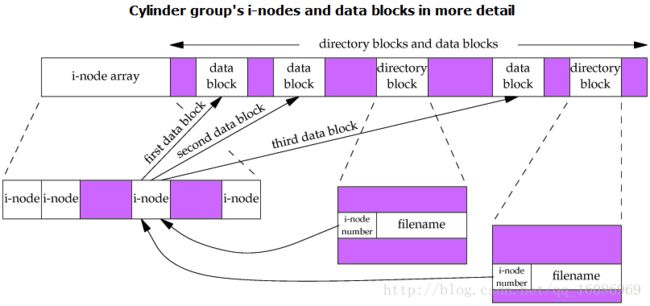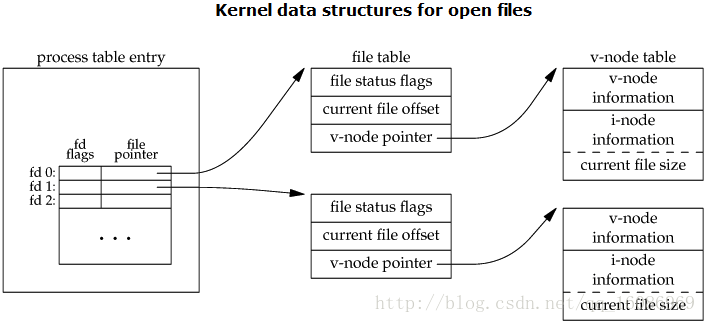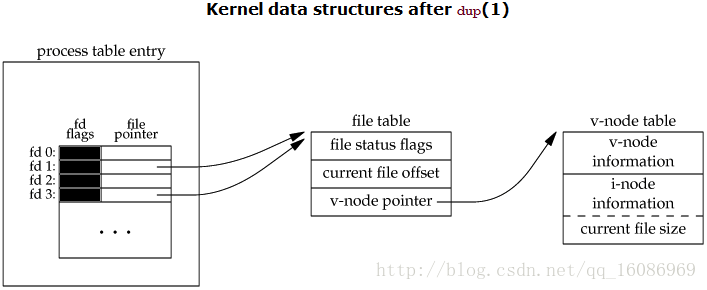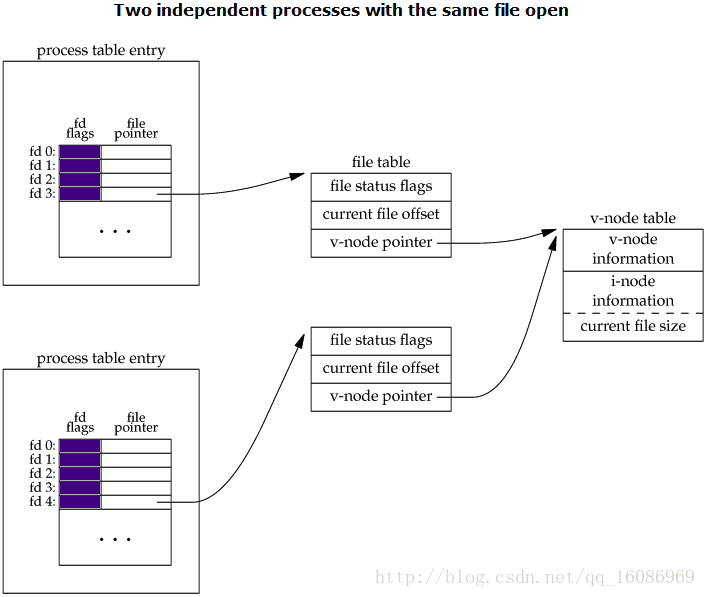c /c++复习笔记 第三天
====================
文件系统(上)
====================
- 一系统调用
- 二文件系统
- 三一切皆文件
- 1 目录文件
- 2 设备文件
- 五文件描述符
- 六opencreatclose
- 范例openc
- 七write
- 范例writec
- 八read
- 范例readc
- 范例binaryc
- 范例textc
- 代码copyc
- 九系统IO与标准IO
- 范例sysioc
- 范例stdioc
- 十lseek
- 范例seekc
- 十一打开文件的内核数据结构
- 范例badc
- 十二dupdup2
- 范例samec
一、系统调用
Unix/Linux大部分系统功能是通过系统调用实现的。
如:open/close。Unix/Linux的系统调用已被封装成C函数的形式,
但它们并不是标准C的一部分。标准库函数大部分时间运行在用户态,
但部分函数偶尔也会调用系统调用,进入内核态。
如:malloc/free。程序员自己编写的代码也可以调用系统调用,
与操作系统内核交互,进入内核态。
如:brk/sbrk/mmap/munmap。系统调用在内核中实现,其外部接口定义在C库中。
该接口的实现借助软中断进入内核。
time命令:测试运行时间
real : 总执行时间
user : 用户空间执行时间
sys : 内核空间执行时间
strace命令:跟踪系统调用二、文件系统
图示:fs.bmp
三、一切皆文件
Linux环境中的文件具有特别重要的意义,
因为它为操作系统服务和设备,
提供了一个简单而统一的接口。
在Linux中,(几乎)一切皆文件。程序完全可以象访问普通磁盘文件一样,
访问串行口、网络、打印机或其它设备。大多数情况下只需要使用五个基本系统调用:
open/close/read/write/ioctl,
即可实现对各种设备的输入和输出。Linux中的任何对象都可以被视为某种特定类型的文件,
可以访问文件的方式访问之。广义的文件
1) 目录文件
# vim day012) 设备文件
A. 控制台:/dev/console
B. 声卡:/dev/audio
C. 标准输入输出:/dev/tty
D. 空设备:/de# cat /dev/tty
Hello, World !
Hello, World !
# echo Hello, World ! > /dev/tty
Hello, World !
# echo Hello, World ! > test.txt
# cat test.txt
Hello, World !
# cat /dev/null > test.txt
# cat test.txt
# find / -name perl 2> /dev/null调用open - 打开/创建文件
creat - 创建空文件
close - 关闭文件
read - 读取文件
write - 写入文件
lseek - 设置读写位置
fcntl - 修改文件属性
unlink - 删除硬链接
rmdir - 删除空目录
remove - 删除硬链接(unlink)或空目录(rmdir)
注意:
- 如果被unlink/remove删除的是文件的最后一个硬链接,
并且没有进程正打开该文件,
那么该文件在磁盘上的存储区域将被立即标记为自由。
反之,如果有进程正打开该文件,
那么该文件在磁盘上的存储区域,
将在所有进程关闭该文件之后被标记为自由。
a -> +-----+
X b -> | ... |
X c -> +-----+- 如果被unlink/remove删除的是一个软链接文件,
那么仅软链接文件本身被删除,其目标不受影响。
+-----+
a -> | ... |
+-----+
+-----+
X b -> | a |
+-----+
+-----+
X c -> | a |
+-----+五、文件描述符
非负的整数。
表示一个打开的文件。
由系统调用(open)返回,
被内核空间(后续系统调用)引用。内核缺省为每个进程打开三个文件描述符:
0 - 标准输入
1 - 标准输出
2 - 标准出错
在unistd.h中被定义为如下三个宏:
#define STDIN_FILENO 0
#define STDOUT_FILENO 1
#define STDERR_FILENO 2范例:redir.c
# a.out 0o.txt 2>e.txt - 文件描述符的范围介于0到OPEN_MAX之间,
传统Unix中OPEN_MAX宏被定义为63,
现代Linux使用更大的上限。
六、open/creat/close
#include 成功返回文件描述符,失败返回-1。
flags为以下值的位或:
O_RDONLY - 只读。\
|
O_WRONLY - 只写。 > 只选一个
|
O_RDWR - 读写。/
O_APPEND - 追加。
O_CREAT - 创建。不存在即创建(已存在即直接打开,
并保留原内容,除非…),
有此位mode参数才有效。
O_EXCL - 排斥。已存在即失败。\
只选一个,
O_TRUNC - 清空。已存在即清空 / 配合O_CREAT使用
(有O_WRONLY/O_RDWR)。
O_NOCTTY - 若pathname指向一个终端设备,
则该终端不会成为调用进程的控制终端。
O_NONBLOCK - 非阻塞。若pathname指向FIFO/块/字符文件,
则该文件的打开及后续操作均为非阻塞模式。
O_SYNC - 写同步。write等待数据和属性,
被物理地写入底层硬件后再返回。
O_DSYNC - 数据写同步。write等待数据,
被物理地写入底层硬件后再返回。
O_RSYNC - 读同步。read等待对所访问区域的所有写操作,
全部物理地写入底层硬件后,再读取并返回。
O_ASYNC - 异步读写。当文件描述符可读/写时,
向调用进程发送SIGIO信号。
open/creat所返回的一定是当前未被使用的,
最小文件描述符。
一个进程可以同时打开的文件描述符个数,
受limits.h中定义的OPEN_MAX宏的限制,
POSIX要求不低于16,传统Unix是63,现代Linux是256。
#include 成功返回0,失败返回-1。
范例:open.c
#include 操作系统可通过权限掩码(当前为0022),
屏蔽程序所创建文件的某些权限位。如:
0666 (rw-rw-rw-) & ~0022 = 0644 (rw-r–r–)
creat函数是通过调用open实现的。
int creat (const char* pathname, mode_t mode) {
return open (pathname,
O_WRONLY | O_CREAT | O_TRUNC, mode);
}
七、write
#include 成功返回实际写入的字节数(0表示未写入),失败返回-1。
size_t: unsigned int,无符号整数
ssize_t: int,有符号整数
范例:write.c
#include 八、read
#include 成功返回实际读取的字节数(0表示读到文件尾),
失败返回-1。
范例:read.c
#include 二进制读写和文本读写。
范例:binary.c
#include 范例:text.c
#include 练习:带覆盖检查的文件复制。
代码:copy.c
#include 九、系统I/O与标准I/O
当系统调用函数被执行时,需要切换用户态和内核态,
频繁调用会导致性能损失。标准库做了必要的优化,内部维护一个缓冲区,
只在满足特定条件时才将缓冲区与系统内核同步,
借此降低执行系统调用的频率,
减少进程在用户态和内核态之间来回切换的次数,
提高运行性能。
范例:sysio.c
#include 范例stdio.c
#include 结果比较:
# time ./sysio
real 0m17.442s
user 0m0.000s
sys 0m0.284s
# time ./stdio
real 0m0.056s
user 0m0.000s
sys 0m0.009s十、lseek
每个打开的文件都有一个与其相关的“文件位置”。
文件位置通常是一个非负整数,
用以度量从文件头开始计算的字节数。读写操作都从当前文件位置开始,
并根据所读写的字节数,增加文件位置。打开一个文件时,除非指定了O_APPEND,
否则文件位置一律被设为0。lseek函数仅将文件位置记录在内核中,
并不引发任何I/O动作。在超越文件尾的文件位置写入数据,
将在文件中形成空洞。文件空洞不占用磁盘空间,但被算在文件大小内。
#include 成功返回当前文件位置,失败返回-1。
whence取值:
SEEK_SET - 从文件头
(文件的第一个字节)。
SEEK_CUR - 从当前位置
(上一次读写的最后一个字节的下一个位置)。
SEEK_END - 从文件尾
(文件的最后一个字节的下一个位置)。
范例:seek.c
#include 思考:既然lseek系统调用相当于标C库函数fseek,
那么是否存在与标C库函数ftell相对应的系统调用?
不存在,
因为通过lseek(fd,0,SEEK_CUR)就可以获得当前文件位置。
思考:如何获取文件的大小?
通过lseek(fd,0,SEEK_END)可以获得文件的大小。
十一、打开文件的内核数据结构
通过ls -i可查看文件的i节点号。
i节点记录了文件的属性和数据在磁盘上的存储位置。
目录也是文件,存放路径和i节点号的映射表。
范例:bad.c
#include 十二、dup/dup2
#include 成功返回文件描述符oldfd的副本,失败返回-1。
复制一个已打开的文件描述符。
返回的一定是当前未被使用的最小文件描述符。
dup2可由第二个参数指定描述符的值。
若指定描述符已打开,则先关闭之。所返回的文件描述符副本,
与源文件描述符,对应同一个文件表。
注意区分通过dup获得的文件描述符副本,
和两次open同一个文件的区别:
dup只复制文件描述符,不复制文件表。
fd1 \
文件表 -> v节点 -> i节点
fd2 /
open创建新文件表,并为其分配新文件描述符。
fd1 -> 文件表1 \
v节点 -> i节点
fd2 -> 文件表2 /
范例:same.c
#include 


